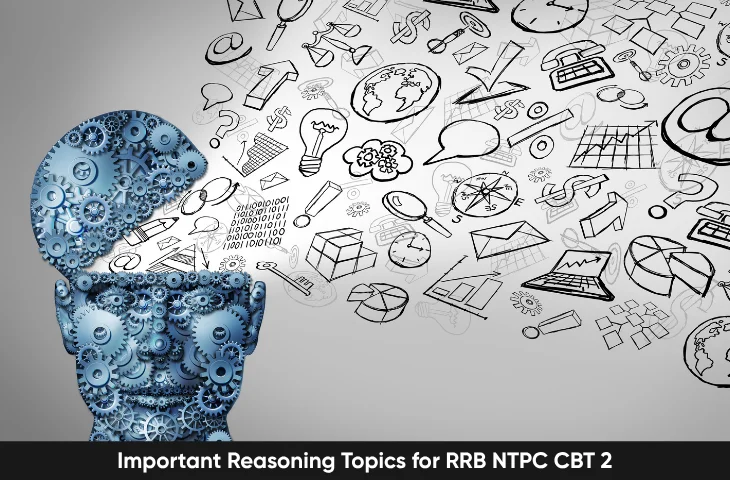The RRB NTPC CBT 2 is a crucial stage in the selection process. For aspirants aiming to secure a good rank, the General Intelligence and Reasoning section is a high-scoring area if approached strategically. This article highlights the Important Reasoning Topics RRB NTPC candidates should focus on, provides topic-wise strategies, examples, and a preparation blueprint to maximize marks.
Why Reasoning Matters in RRB NTPC CBT 2?
Reasoning is one of the high scoring areas among the other topics in the RRB NTPC Syllabus for CBT 2. Given below are some details:
- Weightage: Around 30–35 questions out of 100 in Part A.
- Scoring potential: Questions are often formulaic; accuracy ensures full marks.
- Speed and logic: Solving reasoning questions quickly improves overall exam performance.
- Cutoff influence: High accuracy in reasoning can significantly improve your normalized score and ranking.
Focusing on high-yield reasoning topics is more effective than attempting all topics superficially.
Core Sections of Reasoning in RRB NTPC CBT 2
The reasoning section is designed to test multiple aspects of your logical ability, observation, and analytical skills. Given below is a brief classification:
| Section | Topics | Number of Questions |
| Verbal Reasoning | Analogies, Classification, Coding-Decoding, Blood Relations, Direction Sense, Alphabet Series, Number Series, Syllogisms | 15–18 |
| Non-Verbal / Pictorial Reasoning | Figure Series, Mirror/Water Images, Paper Folding, Embedded Figures, Figure Matrices | 10–12 |
| Critical Reasoning | Statements & Assumptions, Statement & Conclusions, Cause & Effect | 5–7 |
Important Reasoning Topics RRB NTPC CBT 2
Given below is a detailed breakdown of the most important reasoning topics based on past RRB NTPC exams:
1. Syllogism
- Weightage: 3–5 Questions
- Focus: All/Some/None, Some not, Venn diagram representation.
- Tip: Use diagrams to visualize relationships; avoid assumptions.
2. Coding-Decoding
- Weightage: 3–4 Questions
- Types: Letter coding, number coding, mixed coding.
- Strategy: Identify patterns systematically; practice letter-to-number mapping.
3. Blood Relations
- Weightage: 2–3 Questions
- Format: Simple family-based questions or puzzle-style problems.
- Tip: Draw family trees for faster deduction.
4. Direction Sense
- Weightage: 2–3 Questions
- Concepts: North, South, East, West directions, relative movement, angles.
- Tip: Always visualize the movement step by step.
5. Alphanumeric & Number Series
- Weightage: 3–4 Questions
- Pattern: Increasing/decreasing sequences, missing numbers/letters.
- Tip: Identify arithmetic or geometric progression; check differences.
6. Analogies & Classification
- Weightage: 2–3 Questions each
- Focus: Finding relationships or odd one out in words or numbers.
- Tip: Understand the relationship type (cause-effect, part-whole, synonym-antonym).
7. Puzzle & Seating Arrangement
- Weightage: 3–5 Questions
- Types: Linear, Circular, 2D arrangements, Multiple condition puzzles.
- Tip: Practice diagram-based problem-solving; organize data in tables.
8. Statement & Conclusion / Statement & Assumption
- Weightage: 2–3 Questions
- Tip: Read the statements carefully; do not assume beyond the given information.
9. Mirror & Water Image, Paper Folding
- Weightage: 2 Questions
- Tip: Practice visualization skills; drawing diagrams helps.
10. Critical Reasoning / Cause & Effect
- Weightage: 2–3 Questions
- Tip: Analyze the given statement critically; distinguish between strong and weak effects.
Topic-Wise Strategy Table
We have given below a topic wise strategy table for the candidates. Check out the details:
| Topic | Difficulty Level | Questions | Preparation Strategy |
| Syllogism | Moderate | 3–5 | Use Venn diagrams; practice previous year questions |
| Coding-Decoding | Easy-Moderate | 3–4 | Identify patterns; note common letter/number mapping |
| Blood Relations | Easy | 2–3 | Draw family trees; solve mini puzzles daily |
| Direction Sense | Easy | 2–3 | Visualize movements; practice compass directions |
| Number & Alphabet Series | Moderate | 3–4 | Identify progression; practice 15–20 daily |
| Analogy & Classification | Easy | 2–3 | Understand relationships; practice synonyms/antonyms |
| Puzzle & Seating Arrangement | Moderate-Hard | 3–5 | Organize info in tables; attempt diagrams |
| Statement & Conclusion / Assumption | Moderate | 2–3 | Avoid assumptions; read carefully |
| Mirror & Water Image | Easy | 2 | Visualize drawings; practice sketching reflections |
| Cause & Effect | Moderate | 2–3 | Identify direct cause-effect relationships |
Preparation Blueprint for Important Reasoning Topics RRB NTPC
To score well and qualify for the exam in the first attempt, candidates need to have a solid preparation strategy.
- Daily Practice: 20–30 questions covering mixed topics.
- Topic Rotation: Rotate topics like Syllogism, Puzzles, Series, and Coding-Decoding every day.
- Mock Tests: Attempt weekly sectional reasoning tests to improve speed and accuracy.
- Error Analysis: Maintain a notebook of mistakes; revise and practice weak areas.
- Visualization Skills: Practice diagrams, seating arrangements, and mirror/water images.
- Time Management: Allocate 20–25 minutes for reasoning in CBT 2, focusing on accuracy.
Key Points
The key points of the article are summarized below:
- Important Reasoning Topics RRB NTPC include Syllogism, Coding-Decoding, Blood Relations, Direction Sense, Series, Analogies, Puzzles, Statement-Conclusion, Mirror & Water Image, and Cause & Effect.
- Focus on high-frequency, high-scoring topics for maximum marks.
- Use Venn diagrams, family trees, and tables for quick deduction.
- Maintain daily practice and error logs for speed and accuracy.
- Mock tests are essential to simulate exam conditions and improve time management.
The General Intelligence and Reasoning section in RRB NTPC CBT 2 can be a decisive factor in your ranking. By focusing on Important Reasoning Topics RRB NTPC, practicing regularly, and using structured methods like diagrams, tables, and shortcuts, aspirants can achieve high accuracy and boost their overall scores.
FAQs
The most important topics include Syllogism, Coding-Decoding, Blood Relations, Direction Sense, Number & Alphabet Series, Analogies, Classification, Puzzles, Statement & Conclusion, Mirror & Water Images, and Cause & Effect. Focusing on these can maximize your score.
Typically, 30–35 questions appear in the General Intelligence and Reasoning section of CBT 2, covering both verbal and non-verbal reasoning.
Practice topic-wise questions daily.
Use Venn diagrams, family trees, and tables for logical deductions.
Maintain an error log to avoid repeating mistakes.
Attempt mock tests to improve speed, accuracy, and time management.
Identify high-yield topics and practice them repeatedly.
Use shortcuts and diagrammatic representation for Syllogism, Puzzles, and Direction Sense.
Attempt questions under timed conditions to simulate exam pressure.
Yes, RRB NTPC often repeats certain high-frequency patterns, including:
Syllogism using All/Some/None
Coding-Decoding with letters/numbers
Family tree-based Blood Relations
Linear and Circular Seating Arrangements
Series and Analogy questions
Focusing on these increases your chances of scoring high in reasoning.
- रेलवे परीक्षा की तैयारी करें, सारी जानकारी यहां देखें
- How to Qualify the RRB NTPC Typing Test? Know Details
- RRB NTPC Safe Zone vs Danger Zone 2025, Check out the Details
- RRB NTPC Typing vs Non-Typing Post, Which is Better?
- RRB NTPC Graduate Cut Off, Check Zone Wise Expected Cut Off
- RRB NTPC Undergraduate Cut Off, Know the Qualifying Marks

Hello there! I’m a dedicated Government Job aspirant turned passionate writer & content marketer. My blogs are a one-stop destination for accurate and comprehensive information on exams like Regulatory Bodies, Banking, SSC, State PSCs, and more. I’m on a mission to provide you with all the details you need, conveniently in one place. When I’m not writing and marketing, you’ll find me happily experimenting in the kitchen, cooking up delightful treats. Join me on this journey of knowledge and flavors!
